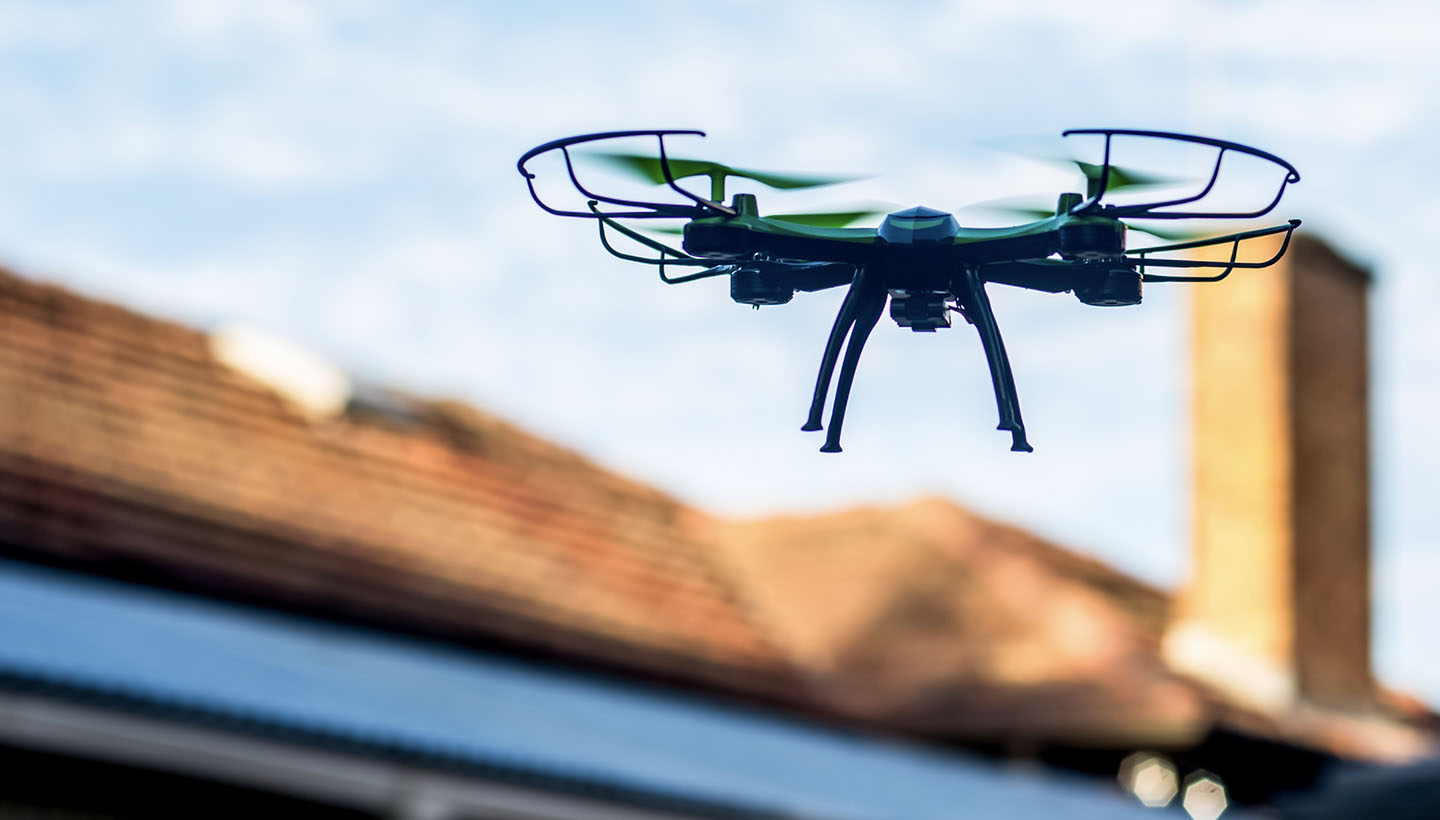
Using Drones for Home Inspections
These days, drones are everywhere. No longer reserved for the military, drones have become popular, high-tech tools used in many industries as well as recreational “toys” enjoyed by hobbyists. They’ve also secured a place in the home inspection toolkit.
While drones are certainly not required to perform a solid home inspection, using one can give you deeper visibility into hard-to-reach areas during an inspection. Like any new tool, there are benefits and drawbacks to consider if you’re thinking about investing in one. Read on to learn what you need to know about drones and home inspections.
Drones: A Short Background
Drones–also known as “unmanned aerial vehicles” (UAVs)–are exactly what the names imply: pilotless remotely operated aircraft. Drones are controlled using a combination of proprietary software, radio wave sensors, GPS technology, and remote controls.
Drones’ popularity and accessibility for commercial and recreational use has grown swiftly in the past two decades. But they’ve actually been around since the early 1900s. Drones were originally developed by the military and initially used as missile deployers during World War I.
The early 2000s saw drone technology become smaller and more accessible for commercial and consumer recreational use. In 2006, the Federal Aviation Administration (FAA) issued its first commercial drone permit. Today, the FAA has a registered log of 338,614 commercial drones and 529,754 recreational drones in the U.S.
Drones are still used heavily in military applications, and they’ve found many more commercial applications since:
- Remote environmental monitoring
- Building and site monitoring
- Policing and surveillance
- Emergency services
- Agricultural observation and monitoring
- Data collection
- Safety inspections
- Product delivery
- Home and building inspections
Drones and Home Inspections
Drones now have a place in the home inspector’s tool bag. They can make parts of a home inspection easier and faster. For example, you can use one to get a closer look at a roof, a chimney, gutters and drainage systems, and other hard-to-reach areas that are either not accessible or not safe to venture into. Drones are also used for landscape and garden inspections, to help confirm property lines, and to take aerial photos and video of a property for real estate use and inspection reports.
The Pros of Using Drones for Home Inspections
Drones are not a required tool for home inspectors. But there are definite pros for adding one to your tool kit and becoming proficient in using it.
Drones Make Roof Inspections Safer
During a home inspection, you may not want to walk on a roof for safety reasons. It’s also not required. While you may be comfortable walking on roofs as part of your inspection routine, with certain homes with easily damaged roofing materials, it isn’t ideal. In these instances, a drone is especially helpful. Fly a drone around the perimeter of your client’s roof to get a closer look at its overall condition, spot problem areas, and zoom in for a more detailed visual inspection–all with your feet safely planted on the ground.
Here’s a great video demonstrating a drone roof inspection from the International Association of Certified Home Inspectors (InterNACHI®).
Drones Help You Inspect Hard-to-Reach Areas
It’s challenging to inspect the harder-to-reach areas of a home, and it makes it more likely that you’ll miss something big. A drone can help you get a closer look at notoriously hard-to-access areas like flashing, fascia, eaves, soffits, gables, gutters, siding, high windows, skylights, solar panels, and more. Drone inspections are also useful for inspecting chimneys and surrounding brick.
Drone Imagery Can Enhance Your Inspection Reports
Many home inspectors use drone imagery to enhance the look, feel, and detail of their inspection reports. The high-resolution photography and video footage taken with a drone can be added to your reports to help your clients see conditions first-hand. This can also help clients gain a better understanding of important issues you find that should be addressed.
Drones Can Be Used With Other Technology for Specialty Inspections
Today’s drones can be outfitted with thermal imaging cameras, moisture meters, thermometers, and gas sensors to help perform specialty inspections. Thermal imaging cameras, which identify heat sources, can help you detect HVAC leaks and airflow inefficiencies. Drones with onboard thermometers can take accurate temperature readings at different areas around a home. Moisture meters on drones can sense areas prone to mold growth due to high moisture content, and drones equipped with gas sensors can detect unhealthy levels of toxic gases like radon.
The Challenges of Using Drones for Home Inspections
As with any new technology, there are some challenges in adding a drone to your inspection toolkit. These points should be considered before you get too deep into drone territory.
Drones Are Expensive
With a starting cost of $1,000 and upward, a good drone is expensive. Not to mention, a drone is delicate, has a limited battery life, has hardware and software requirements, and must be properly maintained. You’ll need to budget for this purchase and shop around for features you want and don’t want. Here’s a helpful round-up of the best drones for roof inspections (as of 2023).
Drones Might Malfunction
Drones aren’t weatherproof. A rainy day will keep your drone grounded. Extreme temperatures can cause your drone to malfunction during operation, and windy days mean drones can’t be flown safely. You’ll need to keep weather conditions in mind and ensure that you’re well-versed in manual inspection methods (the standards) for those times you can’t use your drone for deeper visibility.
You Need an FAA License
When it comes to drones, you can’t just buy and fly. You need a license, which means passing an exam. Training and knowledge of the rules is required to operate a drone safely and legally. So if you’re planning to invest in a drone, you’ll also need to invest some time in the education required to fly it. See the FAA’s drone regulations (and the next section) for more information.
Drones Don’t Replace Home Inspection Standards
Using a drone doesn’t and shouldn’t replace home inspection standards. It’s still very possible to conduct a thorough roof inspection–meeting home inspector best practices–without one. A drone is a tool used only for added visibility. It’s still important to invest in comprehensive home inspector training to learn the standard methods of a solid home inspection.
How to Add a Drone to Your Home Inspection Toolkit
If you want to begin using a drone in your home inspection business, you need a plan of action. These are the steps you should take to ensure you’re using your drone legally and setting proper client expectations.
Research Your Drone Before Purchasing
Drones come in all shapes and sizes, not to mention flight times, software types, image resolutions, battery life, and more. They can also get pricey, so it helps to have a wish list of features you’re looking for. Do your research and talk to people you know who own and fly drones to get their take on potential issues.
Droneblog is a great resource to start reading up on drone types and best flight practices.
Follow FAA Rules and Regulations
In the U.S., you must be certified by the FAA to legally fly a drone when you’re using it for commercial purposes, like property inspection. Your drone must also be FAA-registered if it’s under 55 pounds.
In order to become a certified commercial drone pilot, you’ll need to pass an exam demonstrating your knowledge of Part 107, the FAA’s Small Unmanned Aircraft System rule. This rule covers everything you need to know about FAA drone flight regulations, operating requirements, and procedures for safely flying drones. The exam must be taken in person at an FAA-approved testing center. To prepare for the exam, you can use the FAA Part 107 Knowledge Test Study Materials or take a course to learn the basics.
InterNACHI® offers a free Certified Drone Pilot Training Course to help home inspectors prepare for the exam. There are also many paid courses available you can find by searching the web. Your state might have one as well.
Once you receive your drone pilot certification, you’ll need to renew it every two years. This involves taking a shorter review exam to ensure your knowledge stays current.
Practice Flying Your Drone
After you’ve met FAA regulations, it’s a good idea to practice flying your drone in various inspection scenarios before you take it out on official inspections.
AHIT Instructor and seasoned home inspector Chris Chirafisi stresses the importance of practicing with your drone.
“You want to make sure you practice A LOT, so you don’t look like an amateur when there is a client present,” Chris said. “There are a lot of different options out there for drones and the individual should be properly trained before using one.”
Set Realistic Client and Community Expectations
Setting realistic expectations with your client before using the drone is also an important step. Drones aren’t a magic fix to find every possible exterior issue a home may have, though clients may think they are.
“I think expectations change for the client when they see this piece of equipment hovering over the home and think it is going to capture every single issue with the roof and chimney,” Chris added.
This is not the case.
“Home inspectors should have something in their client inspection agreement that addresses the limitations of using the drone,” he said.
It’s also a good idea to alert surrounding neighbors that you’ll be using a drone as part of your home inspection. This helps avoid any misunderstandings and ensures neighbors know their privacy is protected.
Have a Pre- and Post-Flight Checklist
As part of FAA-compliant drone operation, you’ll need to have a pre- and post-flight checklist detailing your drone use for every inspection. Your checklist should include safety checks, equipment checks, battery life monitoring, connectivity monitoring, a visual inspection of the drone, and a thorough cleaning of it when you’re done.
You can learn how to create a well-rounded pre- and post-flight checklist here.
Get Insurance Coverage
If you plan to add a drone to your inspection services, it’s important to make sure you have the right insurance coverage.
According to OREP, an insurance carrier that offers both Errors and Omissions and General Liability insurance for home inspectors, you should update your existing policy to include general liability coverage for your drone. Basic general liability coverage covers you if your drone damages property or injures a person during an inspection. But it will not cover your expensive drone. A separate rider for drone insurance claims is necessary.
The Future of Drones in Home Inspections
Drones may seem as if they’re growing in popularity in part because of the draw of new technology. But not every home inspector uses one.
“I don’t use a drone in my business and in 21 years of being a home inspector, I have been asked maybe once if I use a drone,” Chris said. “But because I don’t use a drone doesn’t mean it’s a bad thing. It’s just a personal preference.”
It’s really up to you to decide the tools you’d like to use in your business. Many clients crave the benefit of a highly detailed, tech-powered inspection report that gives them more intelligence about a home they’re about to purchase. Using a drone during inspections is also a great way to stand out from your competition and you can take advantage of it in your marketing.
Remember that there are many other methods you can use to inspect a roof and other hard-to-reach spots that don’t involve an expensive drone, an exam to pass, and another license to renew.
Drones and other high-tech tools are poised to continue carving out a place in home inspection over the next decade. But what remains most important for home inspectors? Staying on top of home inspection standards.
AHIT Training Keeps You Current on Home Inspection Best Practices
AHIT’s best-in-class home inspector training course, home inspection certification programs, and professional development courses help you learn the fundamentals of home inspection and keep your knowledge current, no drone required. Find your state course and get started today.




